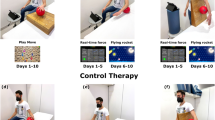Abstract
The present work introduces ShoulPhy: a digital application, which includes a rehabilitation protocol for the treatment of shoulder impingement syndrome (SIS). ShoulPhy, short for Shoulder Physiotherapy enables the development of a patient-centred physiotherapy program and the remote monitoring of the patient’s adherence to the program, both in the clinic and daily life. The application provides a quantitative and effective evaluation of the therapeutic activity and functional level, through the use of wearable devices. The final aim was to facilitate the functional physical recovery and maintenance gained through the rehabilitation program, thus leading to a complete return to sport and routine activities. ShoulPhy underwent small scale tests both on healthy subjects and clinicians, which, in addition to evaluating the technical reliability of the system, assessed the usability and acceptance by clinicians and patients.








Similar content being viewed by others
References
Agnesini N, Neri V, Lorussi F (2018) Between classical and applied ethics, emerging studies: the shoulpy case. Dissertation. Department of Civilisations and Forms of Knowledge University of Pisa
Brotzam S, Wilk K (2004) Clinical orthopedidic rehabilitation. Excerta Medica-Elsevier edn, pp 142–161
Carbonaro N, Dalle Mura G, Lorussi F, Paradiso R, De Rossi D, Tognetti A (2014) Exploiting wearable goniometer technology for motion sensing gloves. IEEE J Biomed Health Inform 18(6):1788–1795
Crosbie J, Kilbreath SL, Hollmann L, York S (2008) Scapulohumeral rhythm and associated spinal motion. Clin Biomech 23(2):184–192
Dahl-Popolizio S, Loman J, Cordes CC (2014) Comparing outcomes of kinect videogame-based occupational/physical therapy versus usual care. Games Health: Research Development, and Clinical Applications 3 (3):157–161
Deary IJ, Der G (2005) Reaction time, age, and cognitive ability: longitudinal findings from age 16 to 63 years in representative population samples. Aging Neuropsychol Cognit 12(2):187–215
Desmeules F, Côté CH, Frémont P (2003) Therapeutic exercise and orthopedic manual therapy for impingement syndrome: a systematic review. Clin J Sport Med 13(3):176–182
Fikar P, Schoenauer C, Kaufmann H (2013) The sorcerer’s apprentice a serious game aiding rehabilitation in the context of subacromial impingement syndrome. In: 2013 7th international conference on pervasive computing technologies for healthcare (PervasiveHealth). IEEE, pp 327–330
Giphart JE, van der Meijden OA, Millett PJ (2012) The effects of arm elevation on the 3-dimensional acromiohumeral distance: a biplane fluoroscopy study with normative data. J Shoulder Elb Surg 21(11):1593–1600
Hanratty CE, McVeigh JG, Kerr DP, Basford JR, Finch MB, Pendleton A, Sim J (2012) The effectiveness of physiotherapy exercises in subacromial impingement syndrome: a systematic review and meta-analysis. Semin Arthritis Rheum 42(3):297–316
Lorussi F, Carbonaro N, De Rossi D, Paradiso R, Veltink P, Tognetti A (2016) Wearable textile platform for assessing stroke patient treatment in daily life conditions. Front Bioeng Biotechnol 4:28
Lorussi F, Carbonaro N, De Rossi D, Tognetti A (2016) A bi-articular model for scapular-humeral rhythm reconstruction through data from wearable sensors. J Neuroeng Rehabil 13(1)
Lucchesi I, Lorussi F, Bellizzi M, Carbonaro N, Casarosa S, Trotta L, Tognetti A (2018) Daily life self-management and self-treatment of musculoskeletal disorders through shoulphy. In: Wireless Mobile Communication and Healthcare. Springer Nature
Matsen FA, Lauder A, Rector K, Keeling P, Cherones AL (2016) Measurement of active shoulder motion using the kinect, a commercially available infrared position detection system. J Shoulder Elb Surg 25(2):216–223
McLaren R, Joseph F, Baguley C, Taylor D (2016) A review of e-textiles in neurological rehabilitation: how close are we. J Neuroeng Rehabil 13(1):59. https://doi.org/10.1186/s12984-016-0167-0
Picavet HSJ, Schouten JSAG (2003) Musculoskeletal pain in the netherlands: prevalences, consequences and risk groups, the dmc 3-study. Pain 102(1):167–178
Ravenek KE, Wolfe DL, Hitzig SL (2016) A scoping review of video gaming in rehabilitation. Disabil Rehabil Assist Technol 11(6):445–453
Report on the impact of musculoskeletal conditions across the member states—European musculoskeletal conditions surveillance and information network. eumusc.net
Stütz T, Emsenhuber G, Huber D, Domhardt M, Tiefengrabner M, Oostingh GJ, Fötschl U, Matis N, Ginzinger S (2017) Mobile phone–supported physiotherapy for frozen shoulder: feasibility assessment based on a usability study. In: JMIR rehabilitation and assistive technologies, vol 4(2)
Van der Windt D, Koes BW, Boeke A, Devillé W, De Jong BA, Bouter LM (1996) Shoulder disorders in general practice: prognostic indicators of outcome. Br J Gen Pract 46(410):519– 523
van Meulen FB, Reenalda J, Buurke JH, Veltink PH (2015) Assessment of daily-life reaching performance after stroke. Ann Biomed Eng 43(2):478–486
Van Rijn RM, Huisstede BM, Koes BW, Burdorf A (2010) Associations between work-related factors and specific disorders of the shoulder—a systematic review of the literature. Scand J Work Environ Health 36(3):189–201
Author information
Authors and Affiliations
Corresponding author
Additional information
Publisher’s Note
Springer Nature remains neutral with regard to jurisdictional claims in published maps and institutional affiliations.
Rights and permissions
About this article
Cite this article
Lorussi, F., Lucchesi, I., Carbonaro, N. et al. Supervised Recovery of Shoulder Muscular Skeletal Disorders Through a Wearable-Enabled Digital Application. Mobile Netw Appl 27, 718–727 (2022). https://doi.org/10.1007/s11036-019-01305-8
Published:
Issue Date:
DOI: https://doi.org/10.1007/s11036-019-01305-8




